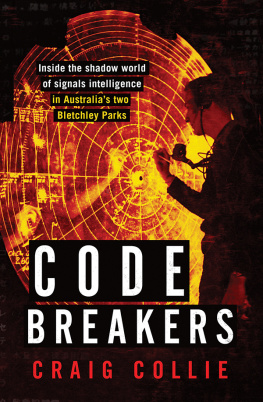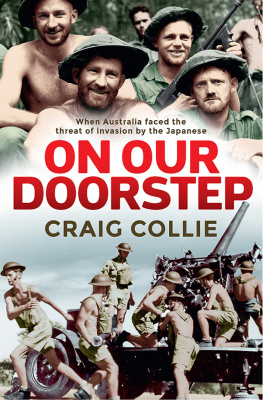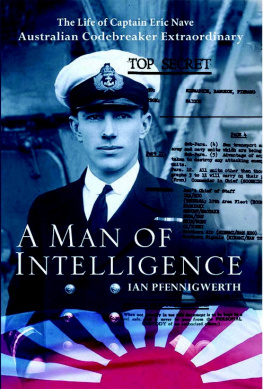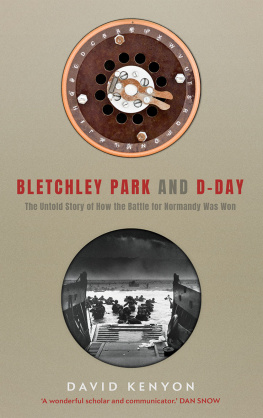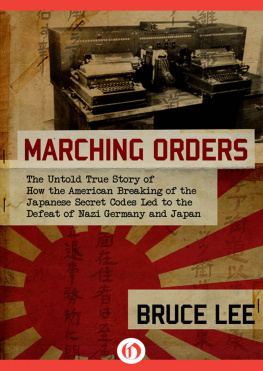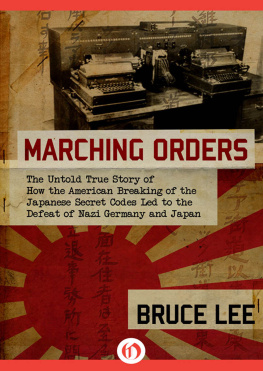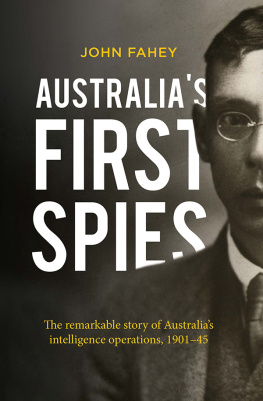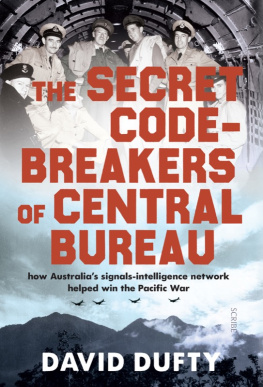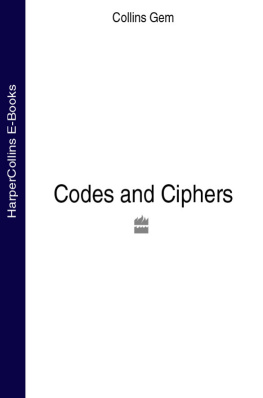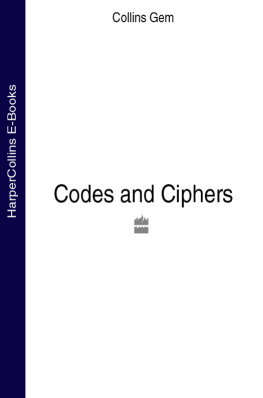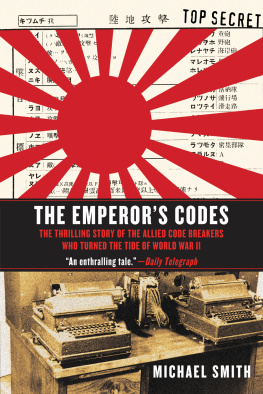
Other books by Craig Collie
Nagasaki: The massacre of the innocent and unknowing (2011)
The Path of Infinite Sorrow: The Japanese on the Kokoda Track (2009)
co-written with Hajime Marutani
The Reporter and the Warlords: An Australian at large
in Chinas republican revolution (2013)
First published in 2017
Copyright Craig Collie 2017
All rights reserved. No part of this book may be reproduced or transmitted in any form or by any means, electronic or mechanical, including photocopying, recording or by any information storage and retrieval system, without prior permission in writing from the publisher. The Australian Copyright Act 1968 (the Act) allows a maximum of one chapter or 10 per cent of this book, whichever is the greater, to be photocopied by any educational institution for its educational purposes provided that the educational institution (or body that administers it) has given a remuneration notice to the Copyright Agency (Australia) under the Act.
Allen & Unwin
83 Alexander Street
Crows Nest NSW 2065
Australia
Phone:(61 2) 8425 0100
Email:
Web:www.allenandunwin.com
Cataloguing-in-Publication details are available from the National Library of Australia
www.trove.nla.gov.au
ISBN 9781743312100
eISBN 9781742699776
Maps by Keith Mitchell
Set by Post Pre-press Group, Australia
Cover design: Lewis Csizmazia
Cover photographs: Time Life Pictures / Getty Images
Contents
| Map 1: | Manila Bay |
| Map 2: | The Battle of the Coral Sea, 1942 |
| Map 3: | Allied advances along the northern New Guinea coast, 1943 |
| Map 4: | Allied assault on Hollandia and its airfields, 1944 |
| Map 5: | No. 6 Wireless Unit landings in support of the Allied invasion of Leyte, 1944 |
| Map 6: | No. 6 Wireless Unit landings in support of the Allied invasion of Luzon, 1945 |
| AIF | Australian Imperial Force |
| ASIO | Australian Security Intelligence Organisation |
| ATIS | Allied Translator and Interpreter Section |
| AWAS | Australian Womens Army Service |
| AWS | Aircraft Warning Service (Philippines) |
| BRUSA | BritainUnited States (Agreement) |
| CGS | Chief of General Staff (Australian Army) |
| CNS | Chief of Naval Staff |
| COIC | Combined Operational Intelligence Centre (Australia) |
| CSO | Chief Signal Officer |
| DCO | District Communications Office (US) |
| D/F | direction finder |
| DNI | Director of Naval Intelligence |
| DSB | Defence Signals Branch (Australia) |
| FECB | Far East Combined Bureau (Hong Kong, Singapore) |
| FRUMEL | Fleet Radio Unit Melbourne (US, Australia) |
| GCCS | Government Code and Cipher School (UK) |
| GHQ | General Headquarters |
| HQ | headquarters |
| IJA | Imperial Japanese Army |
| IJN | Imperial Japanese Navy |
| MI5 | Military Intelligence, Section 5 (UK) |
| MI6 | Military Intelligence, Section 6 (UK) |
| POW | prisoner of war |
| RAAF | Royal Australian Air Force |
| RAN | Royal Australian Navy |
| RFP | radio fingerprinting |
| RN | Royal Navy (UK) |
| SIB | Special Intelligence Bureau (Australia) |
| sigint | signals intelligence |
| SIS | Signal Intelligence Service (US) |
| SWPA | Southwest Pacific Area (US/Australia) |
| SWS | Special Wireless Section (Australia) |
| TICOM | Target Intelligence Committee |
| USAAF | United States Army Air Force |
| USN | United States Navy |
| WAAAF | Womens Auxiliary Australian Air Force |
| WAC | Womens Army Corps (US) |
| WRANS | Womens Royal Australian Naval Reserve |
| WU | Wireless Unit |
Relationship of Allied code-breaking units
Like a messenger from the dark side, a lone despatch rider roars out of Park Orchards, a trail of dust from the gravel road settling slowly behind him in the early-morning glow. Cottages vacated for the military, and untended apple and pear orchards, are left behind. The growling motorcycle with its oversized headlamp winds downhill through scrubby eucalypt bushland towards central Melbourne, some 30 kilometres away. It is November 1941, and Europe has been at war for two years.
Now trouble is brewing closer to home, with a belligerent Japan chided by the United States over its military incursions into China. Word is that the handwritten notes inside the sealed bag strapped to the mans chest have something to do with that, but this Don Rjargon for despatch riderhas no idea what he is carrying and doesnt really care. Anonymous in goggles, helmet and dark jacket, he has been ordered to deliver the package to an office in Victoria Barracks, on St Kilda Road, and that is what he does.
Built in the mid-nineteenth century to house British troops, the imposing main building now houses the Defence Secretariat and the War Cabinet room. The new Prime Minister, John Curtin, has an office there, too. When Australias federal government moved to Canberra in 1927, the Department of Defence and the administrations of all three armed forces remained in Melbourne.
With the war too distant for security measures to be any more than cursory, the despatch rider is allowed to enter the fortress-like complex with minimal scrutiny. In any case, hes a familiar figure there, and he heads straight for the new red-brick headquarters of Australias navy and air force. The sealed bag from Park Orchards is delivered to an office tucked out of the way. A wooden plaque on its door announces the occupant as Commander T.E. Nave, but theres no indication of what position he holds. In fact, Eric Nave is head of a compact unit of ten people, the newly formed Special Intelligence Bureau (SIB). Only a handful of people in the military and the government know of its existence, and only a select few of those understand its function.
Trim and erect, with sharp features and receding grey hair, 42-year-old Nave is every inch a naval officer. Standoffish and formal, perhaps from shyness, he has a steely determination that will shape his career for better or worse. Transferred from the Royal Australian Navy (RAN) to the Royal Navy (RN), for which he worked in signals intelligence in Hong Kong and Singapore, he returned to Australia after developing tropical sprue, a debilitating digestive disease. Continuing the secretive work he was doing in Singapore, in June 1940, Nave set up a cryptographic group dedicated to breaking Japans diplomatic and commercial codes. Melbourne is too far from Japanese military operations to consistently intercept their communications, but a diplomatic corps has missions all around the world.
The wireless intercept station at Park Orchards is operated by the Australian Army. It has agreed to supply the Special Intelligence Bureau with copies of any radio messages it intercepts from Japan, whether voice transmissions or signals in the Japanese version of Morse code.
Next page
